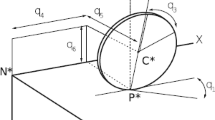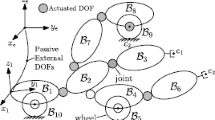Abstract
This paper describes a collection of methods and procedures for the automatic generation of the equations of motion of multibody systems using general-purpose Computer Algebra Software. A brief review of existing symbolic multibody systems is given, and advantages and disadvantages of symbolic approaches compared with numerical ones are discussed. Then, a set of methods for symbolic modeling of multibody systems is explained. The first step of the modeling procedure consists of the description of the multibody system, by defining objects (such as points, vectors, rigid bodies, forces and torques, special objects) and the relationships between them (kinematic chains, constraints). The second step is the derivation of the equations of motion, which can be performed in a quasiautomatic way. A further step is the linearization of the equations and the calculation of the system's frequency response functions. By way of example, a dynamic model of the motorcycle is developed, obtaining the nonlinear equations of motion in a dependent coordinates' formulation. Next, the equations of motion are linearized and reduced to an independent formulation, reobtaining the well known Sharp's model of the straight running of the motorcycle. Root loci and frequency response functions are also calculated. This example demonstrates the power of the given symbolic procedures and shows how a model suitable for stability, handling and control analysis can be developed quickly and easily. The procedure described in this paper has been implemented in a Maple package called ‘MBSymba’, which is available on the web page www.dim.unipd.it/lot/mbsymba.html.
Similar content being viewed by others
References
Lieh, J. and Haque, I., 'Symbolic closed-form modeling and linearization of multibody systems subject to control', Journal of Mechanisms, Transmissions, and Automation in Design 113, 1991, 124–132.
Sayers, M.W., Symbolic computer language for multibody systems, Journal of Guidance, Control, and Dynamics 14, 1991, 1153–1163.
Nikravesh, P.E. and Ambrosio, J.A.C., 'Automatic construction of equations of motion for rigid-flexible multibody systems', Winter Annual Meeting of the American Society of Mechanical Engineers, 8-13, November 1992, ASME, New York, Anaheim, CA, USA, 125–132.
Sreenath, N., 'Hybrid computation environment for multibody simulation', Mathematics and Computers in Simulation 34, 1992, 121–140.
Lieh, J., 'Computer-oriented closed-form algorithm for constrained multibody dynamics for robotics applications', Mechanism and Machine Theory 29, 1994, 357–371.
Cui, K., Haque, I. and Thirumalai, M., 'On configurations of symbolic equations, of motion for rigid multibody systems', Mechanism and Machine Theory 30, 1995, 1149–1170.
McPhee, J., Ishac, M.G. and Andrews, G.C., 'Wittenburg's formulation of multibody dynamics equations from a graph-Theoretic perspective', Mechanism and Machine Theory 31, 1996, 201–213.
Pagalday, J.M. and Avello, A., 'Optimization of multibody dynamics using object oriented programming and a mixed numerical-symbolic penalty formulation', Mechanism and Machine Theory 32, 1997, 161–174.
Cui, K. and Haque, I., 'Symbolic equations of motion for hybrid multibody systems using a matrix-vector formulation', Mechanism and Machine Theory 32, 1997, 743–763.
Blankenship, G.L., Kwatny, H.G., La Vigna, C. and Polyakov, V., 'Integrated modeling and design of nonlinear control systems', American Control Conference, Albuquerque, NM, USA, June 4-6, 1997, IEEE, Piscataway, NJ 1395–1399.
Kecskemethy, A., Krupp, T. and Hiller, M., 'Symbolic processing of multiloop mechanism dynamics using closed-form kinematics solutions', Multibody System Dynamics 1, 1997, 23–45.
McPhee, J., 'Automatic generation of motion equations for planar mechanical systems using the new set of "Branch coordinates" ', Mechanism and Machine Theory 33, 1998, 805–823.
Park, F.C., Choi, J. and Ploen, S.R., 'Symbolic formulation of closed chain dynamics in independent coordinates', Mechanism and Machine Theory 34, 1999, 731–751.
Shi, P. and McPhee, J., 'Dynamics of flexible multibody systems using virtual work and linear graph theory', Multibody System Dynamics 4, 2000, 355–381.
Fisette, P., Postiau, T., Sass, L. and Samin, J.C., 'Fully symbolic generation of complex multibody models', Mechanics of Structures and Machines, 30, 2002, 31–82.
Da Lio, M. and Bortoluzzi, D., 'Symbolic derivation of open-loop dynamic models of multibody mechatronic systems for control purpose. A case study: The Lisa technology package', 5th ESA International Conference on Spacecraft Guidance, Navigation and Control Systems, Frascati, Rome, Italy, October 22-25, 2002, SP–516.
Sharp, R.S., 'The stability and control of motorcycles', Journal of Mechanical Engineering Science 13, 1971.
Cossalter V. and Lot, R., 'A motorcycle multi-body model for real time simulations based on the natural coordinates approach', Vehicle System Dynamics 37, 2002 423–448.
Wolfram, S., The Mathematica Book, Cambridge University Press, Cambridge, UK, 1999.
Garvan, F., The MAPLE Book, Chapman & Hall, 2001.
Crandall, S.H., Karnopp, D.C., Kurtz, E. F. and Pridmore-Brown, D. C., Dynamics of Mechanical and Electromechanial Systems, McGraw-Hill, New York, 1968.
Meirovitch, L., Methods of Analytical Dynamics, McGraw-Hill, New York, 1970.
Greenwood, D.T., Classical Mechanics, Prentice-Hall, Englewood Cliffs, 1977.
Sush, H. and Radcliffe, C.W., Kinematics and Mechanism Design, Wiley, New York, 1978.
Goldstein, H., Classical Mechanics, Addison-Wesley, Reading, 1981.
Kane, T.R. and Levinson, D.A., Dynamics: Theory and Application, McGraw-Hill, New York, 1985.
Arnold, V.I., Mathematical Methods of Classical Mechanics, Springer-Verlag, New York, 1989.
Chetaev, N.G., Theoretical Mechanics, Springer-Verlag, New York, 1989.
Haug, E.J., Computer-Aided Kinematics and Dynamics of Mechanical Systems, Allyn and Bacon, Boston, 1989.
Amirouche, F., Computational Methods in Multibody Dynamics, Prentice-Hall, Inc., Englewood Cliffs, NJ, 1992.
de Jalon J.G. and Bayo, E., Kinematic and Dynamic Simulation of Multibody Systems, Springer Verlag, Berlin, 1994.
Ginsberg, J., Advanced Engineering Dynamics, Cambridge University Press, Cambridge, UK, 1995.
Torok, J.S., Analytical Mechanics, Wiley, 1999.
Pennestrì, E., Dinamica Tecnica e Computazionale, Vol. 2, Editrice Ambrosiana, 2001 (in Italian).
Hairer, E. and Wanner, G., Solving Ordinary and Differential Equations II, Stiff and Differential-Algebraic Problems, Springer Verlag, Berlin, 1991.
Martins De Carvalho, J.L., Dynamical Systems and Automatic Control, Prentice Hall, Inc., Englewood cliffs, NJ, 1993, ISSN 0132217554.
Author information
Authors and Affiliations
Rights and permissions
About this article
Cite this article
Lot, R., Lio, M.D. A Symbolic Approach for Automatic Generation of the Equations of Motion of Multibody Systems. Multibody System Dynamics 12, 147–172 (2004). https://doi.org/10.1023/B:MUBO.0000044319.63215.22
Issue Date:
DOI: https://doi.org/10.1023/B:MUBO.0000044319.63215.22




